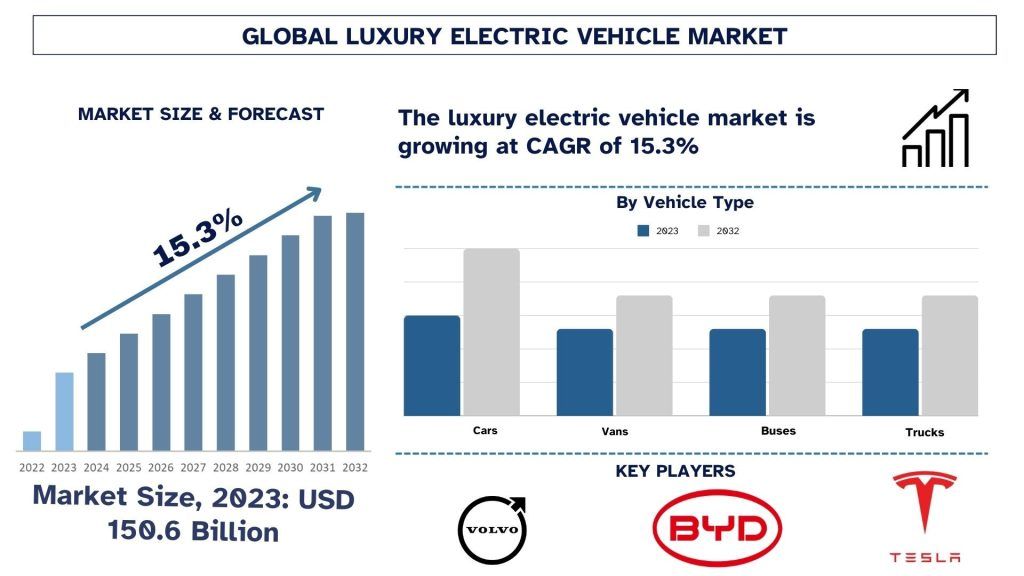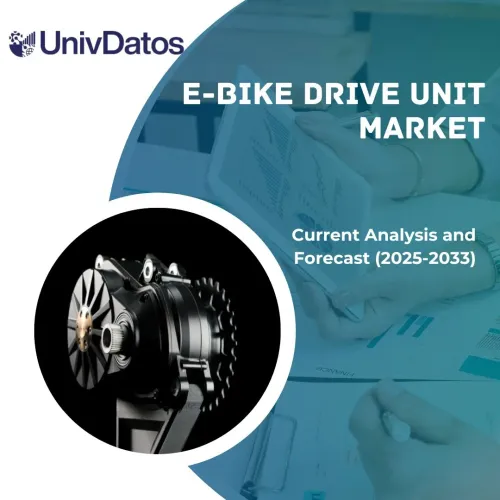- الرئيسية
- معلومات عنا
- صناعة
- الخدمات
- قراءة
- اتصل بنا
سوق السيارات الكهربائية الفاخرة: التحليل الحالي والتوقعات (2024-2032)
التركيز على نوع نظام الدفع (مركبة كهربائية تعمل بالبطارية، ومركبة كهربائية هجينة تعمل بالكهرباء، ومركبة كهربائية تعمل بخلايا الوقود)؛ نوع المركبة (سيارات، وشاحنات صغيرة، وحافلات، وشاحنات)؛ والمنطقة/الدولة
حجم سوق المركبات الكهربائية الفاخرة والتوقعات
بلغت قيمة سوق المركبات الكهربائية الفاخرة حوالي 150.6 مليار دولار أمريكي في عام 2023 ومن المتوقع أن ينمو بمعدل نمو سنوي مركب قوي يبلغ حوالي 15.3٪ خلال الفترة المتوقعة (2024-2032) بسبب زيادة طلب المستهلكين على وسائل النقل الصديقة للبيئة والتطورات التكنولوجية والحوافز الحكومية للتنقل الكهربائي.
تحليل سوق المركبات الكهربائية الفاخرة
إن ارتفاع الطلب على المركبات الخالية من الانبعاثات والمكافحة لتلوث الهواء والموفرة للوقود والمتقدمة تقنيًا يدفع نمو سوق المركبات الكهربائية الفاخرة. بالإضافة إلى ذلك، كان لزيادة ميل المستهلكين نحو ميزات الترفيه والسلامة والراحة تأثير إيجابي على نمو السوق. إلى جانب ذلك، أدى تزايد عدد الأفراد ذوي الثروات العالية (HNWIs) والأفراد ذوي الثروات العالية جدًا (UHNWIs) في الاقتصادات الناشئة في منطقة آسيا والمحيط الهادئ إلى دفع الطلب على المركبات الكهربائية الفاخرة.
تشهد صناعة السيارات حاليًا تحولًا كبيرًا، لا سيما في قطاع السيارات الفاخرة، وذلك بسبب ظهور المركبات الكهربائية (EVs). فيما يلي بعض الأسباب التي تؤثر على هذا التغيير: أولاً، هناك اتجاه متزايد في انبعاثات الغازات الدفيئة في العالم، وبالتالي يبحث مستهلكو السيارات الفاخرة عن أنظمة نقل صديقة للبيئة. ثانيًا، إن المعدلات العالية جدًا للنمو التكنولوجي للسيارات الكهربائية وبطارياتها وتطوير خيارات جديدة لشحن البطاريات قد جعلت هذه القطاعات من المركبات الكهربائية مستقرة وجذابة لمجموعة واسعة من المستهلكين. أخيرًا، هناك اتجاهات مثل التحول إلى الميزات والاتصال وتجارب التنقل الفاخرة الراقية الجديدة التي تتماشى جيدًا مع الخصائص التي تحدد المركبات الكهربائية الفاخرة.
اتجاهات سوق المركبات الكهربائية الفاخرة
يناقش هذا القسم اتجاهات السوق الرئيسية التي تؤثر على قطاعات سوق المركبات الكهربائية الفاخرة كما حددها خبراء الأبحاث لدينا.
المركبات الكهربائية التي تعمل بالبطاريات تحول الصناعة
استحوذ قطاع المركبات الكهربائية التي تعمل بالبطاريات على أكبر حصة في السوق. إن الزيادة في الوعي البيئي، فضلاً عن مبادرات الحكومات المختلفة التي تهدف إلى نمو واردات المركبات الكهربائية في جميع أنحاء العالم، تساهم أيضًا في زيادة قطاع المركبات الكهربائية التي تعمل بالبطاريات في السوق العالمية. إلى جانب ذلك، فإن الميل الأعلى لشركات صناعة السيارات لتطوير أنواع مختلفة من المركبات الكهربائية مع ميزات الذكاء الاصطناعي وإنترنت الأشياء المدمجة يغذي أيضًا نمو القطاع. على سبيل المثال، تعتزم شركة Audi AG، إحدى الشركات الرئيسية في الصناعة، إطلاق سيارة 2023 Audi e-tron® GT في عام 2023، والمجهزة بمصابيح أمامية LED بتصميم Matrix، وتقليم X-frame، وأضواء الليزر.
من المتوقع أن تنمو منطقة آسيا والمحيط الهادئ بمعدل نمو سنوي مركب كبير خلال الفترة المتوقعة
من المتوقع أن تنمو منطقة آسيا والمحيط الهادئ بمعدل نمو سنوي مركب كبير خلال الفترة المتوقعة. من المتوقع أن تحافظ المنطقة على مكانتها خلال الفترة المتوقعة بسبب الاهتمام المتزايد من الحكومة بتطوير محطات شحن البطاريات ومحطات تزويد الهيدروجين بالوقود في البلدان النامية بما في ذلك الصين والهند. على سبيل المثال، الهدف الأخير الذي وضعته الحكومة الصينية هو تطوير وبيع مركبات خلايا وقود الهيدروجين لتحل محل الأساطيل الحالية. لقد وضعوا هدفًا طموحًا، بهدف وجود مليون مركبة كهربائية تعمل بخلايا الوقود على الطريق وتركيب 1000 محطة لتزويد الهيدروجين بالوقود بحلول عام 2030. وبالتالي، فإن الإجراءات الحكومية تهدف إلى تعزيز اختراق مشتقات البطاريات الكهربائية وخلايا الوقود الكهربائية الفاخرة في السوق.
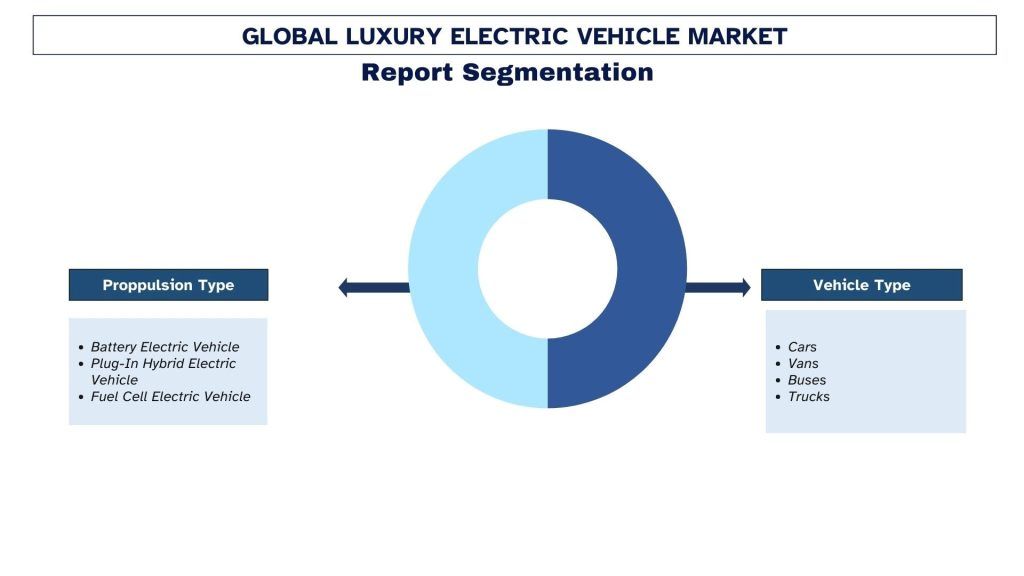
نظرة عامة على صناعة المركبات الكهربائية الفاخرة
سوق المركبات الكهربائية الفاخرة سوق تنافسي، مع وجود العديد من اللاعبين العالميين والدوليين في السوق. يتبنى اللاعبون الرئيسيون استراتيجيات نمو مختلفة لتعزيز وجودهم في السوق، مثل الشراكات والاتفاقيات والتعاون وإطلاق منتجات جديدة والتوسعات الجغرافية وعمليات الاندماج والاستحواذ. بعض اللاعبين الرئيسيين العاملين في السوق هم Tesla Inc.، و AB Volvo، و BYD Auto Co.، Ltd.، و Ford Motor Company، و Hyundai Motor Company، و Volkswagen AG.، و BMW AG، و Toyota Motor Corporation، و Kia Corporation، و Audi AG.
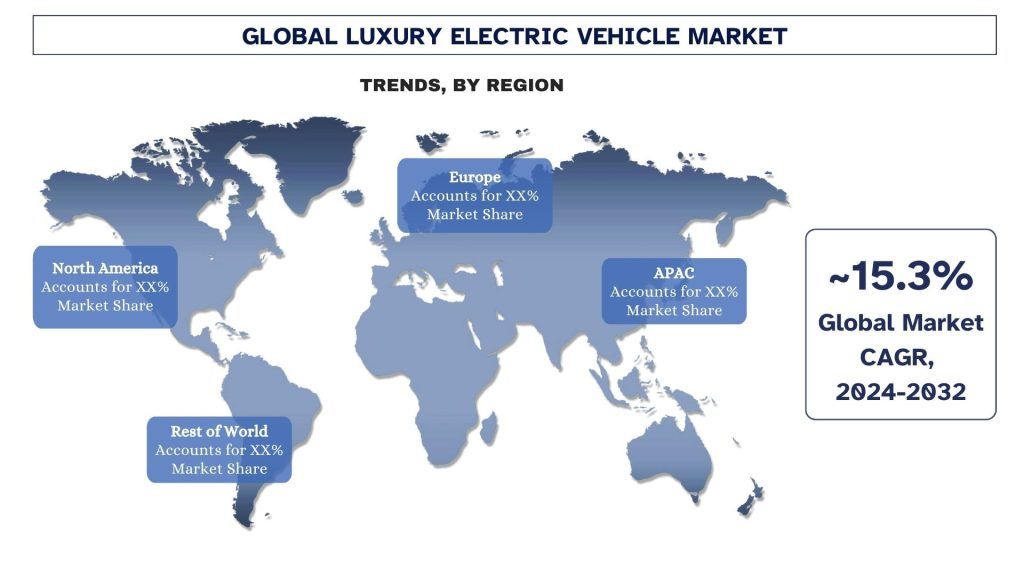
أخبار سوق المركبات الكهربائية الفاخرة
على سبيل المثال، في أبريل 2022، أطلقت شركة BYD Auto Co., Ltd. سلسلة Han EV، والتي تتضمن مجموعة واسعة من المركبات تتراوح من المركبات متوسطة المستوى إلى سيارات السيدان الفاخرة. تتضمن السلسلة كلاً من المركبات الكهربائية التي تعمل بالبطاريات والمركبات الهجينة القابلة للشحن.
في عام 2024، أطلقت شركة Kia India أيضًا سيارة الدفع الرباعي الكهربائية الفاخرة EV9 اليوم. تدخل سيارة Kia EV9 إلى البلاد في شكل مكتمل تمامًا (CBU)، وستنافس سيارتي Mercedes-Benz EQE و BMW iX. للإشارة، EV9 هي أغلى سيارة من كيا وأيضًا السيارة الأكثر تطوراً التي طورتها شركة صناعة السيارات على الإطلاق
تغطية تقرير سوق المركبات الكهربائية الفاخرة
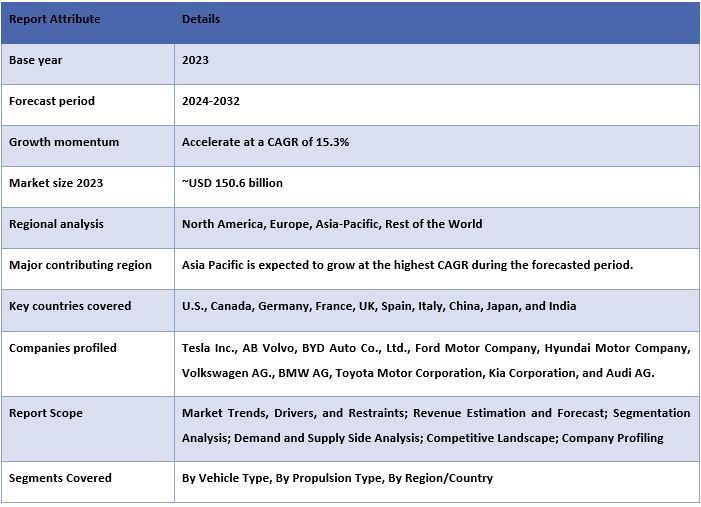
أسباب شراء هذا التقرير:
- تتضمن الدراسة قياس حجم السوق وتحليل التوقعات الذي تم التحقق منه من قبل خبراء الصناعة الرئيسيين الموثوقين.
- يقدم التقرير مراجعة سريعة لأداء الصناعة بشكل عام في لمحة.
- يغطي التقرير تحليلًا متعمقًا لنظراء الصناعة البارزين مع التركيز الأساسي على البيانات المالية الرئيسية للأعمال، ومحافظ المنتجات، واستراتيجيات التوسع، والتطورات الأخيرة.
- فحص تفصيلي للدوافع والقيود والاتجاهات الرئيسية والفرص السائدة في الصناعة.
- تغطي الدراسة السوق بشكل شامل عبر قطاعات مختلفة.
- تحليل متعمق على المستوى الإقليمي للصناعة.
خيارات التخصيص:
يمكن تخصيص سوق المركبات الكهربائية الفاخرة العالمي بشكل أكبر وفقًا للمتطلبات أو أي قطاع سوق آخر. إلى جانب ذلك، تدرك UMI أن لديك احتياجات عمل خاصة بك؛ لذا، لا تتردد في التواصل معنا للحصول على تقرير يناسب متطلباتك تمامًا.
جدول المحتويات
منهجية البحث لتحليل سوق السيارات الكهربائية الفاخرة (2022-2032)
كان تحليل السوق التاريخي وتقدير السوق الحالي والتنبؤ بالسوق المستقبلي لسوق السيارات الكهربائية الفاخرة العالمي هي الخطوات الرئيسية الثلاث التي تم اتخاذها لإنشاء وتحليل اعتماد السيارات الكهربائية الفاخرة في المناطق الرئيسية على مستوى العالم. تم إجراء بحث ثانوي شامل لجمع أرقام السوق التاريخية وتقدير حجم السوق الحالي. ثانيًا، تم أخذ العديد من النتائج والافتراضات في الاعتبار للتحقق من صحة هذه الرؤى. علاوة على ذلك، تم إجراء مقابلات أولية شاملة مع خبراء الصناعة عبر سلسلة القيمة لسوق السيارات الكهربائية الفاخرة العالمي. بعد افتراض أرقام السوق والتحقق من صحتها من خلال المقابلات الأولية، استخدمنا نهجًا من أعلى إلى أسفل/من أسفل إلى أعلى للتنبؤ بحجم السوق الكامل. بعد ذلك، تم اعتماد طرق تقسيم السوق وتثليث البيانات لتقدير وتحليل حجم سوق القطاعات والقطاعات الفرعية للصناعة. يتم شرح المنهجية التفصيلية أدناه:
تحليل حجم السوق التاريخي
الخطوة 1: دراسة متعمقة للمصادر الثانوية:
تم إجراء دراسة ثانوية تفصيلية للحصول على حجم السوق التاريخي لسوق السيارات الكهربائية الفاخرة من خلال مصادر الشركة الداخلية مثل التقارير السنوية والبيانات المالية وعروض الأداء والنشرات الصحفية وما إلى ذلك، والمصادر الخارجية بما في ذلك المجلات والأخبار والمقالات والمنشورات الحكومية ومنشورات المنافسين وتقارير القطاعات وقاعدة بيانات الطرف الثالث والمنشورات الموثوقة الأخرى.
الخطوة 2: تقسيم السوق:
بعد الحصول على حجم السوق التاريخي لسوق السيارات الكهربائية الفاخرة، أجرينا تحليلًا ثانويًا مفصلًا لجمع رؤى السوق التاريخية وحصتها للقطاعات والقطاعات الفرعية المختلفة للمناطق الرئيسية. يتم تضمين القطاعات الرئيسية في التقرير، مثل نوع الدفع ونوع السيارة والمناطق. تم إجراء المزيد من التحليلات على مستوى الدولة لتقييم الاعتماد الكلي لنماذج الاختبار في تلك المنطقة.
الخطوة 3: تحليل العوامل:
بعد الحصول على حجم السوق التاريخي للقطاعات والقطاعات الفرعية المختلفة، أجرينا تحليلًا تفصيليًا للعوامل لتقدير حجم السوق الحالي لسوق السيارات الكهربائية الفاخرة. علاوة على ذلك، أجرينا تحليلًا للعوامل باستخدام متغيرات تابعة ومستقلة مثل نوع الدفع ونوع السيارة ومناطق سوق السيارات الكهربائية الفاخرة. تم إجراء تحليل شامل لسيناريوهات الطلب والعرض مع الأخذ في الاعتبار أهم الشراكات وعمليات الاندماج والاستحواذ والتوسع التجاري وإطلاق المنتجات في قطاع سوق السيارات الكهربائية الفاخرة في جميع أنحاء العالم.
تقدير حجم السوق الحالي والتنبؤ به
تحديد حجم السوق الحالي: بناءً على رؤى قابلة للتنفيذ من الخطوات الثلاث المذكورة أعلاه، توصلنا إلى حجم السوق الحالي واللاعبين الرئيسيين في سوق السيارات الكهربائية الفاخرة العالمي والحصص السوقية للقطاعات. تم تحديد جميع النسب المئوية المطلوبة وتقسيمات السوق باستخدام النهج الثانوي المذكور أعلاه وتم التحقق منها من خلال المقابلات الأولية.
التقدير والتنبؤ: لتقدير السوق والتنبؤ به، تم تخصيص أوزان لعوامل مختلفة بما في ذلك المحركات والاتجاهات والقيود والفرص المتاحة لأصحاب المصلحة. بعد تحليل هذه العوامل، تم تطبيق تقنيات التنبؤ ذات الصلة، أي النهج من أعلى إلى أسفل/من أسفل إلى أعلى، للوصول إلى توقعات السوق لعام 2032 للقطاعات والقطاعات الفرعية المختلفة عبر الأسواق الرئيسية على مستوى العالم. تتضمن منهجية البحث المعتمدة لتقدير حجم السوق ما يلي:
- حجم سوق الصناعة، من حيث الإيرادات (بالدولار الأمريكي) ومعدل اعتماد سوق السيارات الكهربائية الفاخرة عبر الأسواق الرئيسية محليًا
- جميع الحصص المئوية وتقسيمات وتوزيعات قطاعات السوق والقطاعات الفرعية
- اللاعبون الرئيسيون في سوق السيارات الكهربائية الفاخرة العالمي من حيث المنتجات المعروضة. أيضًا، استراتيجيات النمو التي يتبناها هؤلاء اللاعبون للمنافسة في السوق سريع النمو
التحقق من صحة حجم السوق وحصته
البحث الأولي: تم إجراء مقابلات متعمقة مع قادة الرأي الرئيسيين (KOLs)، بما في ذلك كبار المديرين التنفيذيين (CXO/VPs، ورئيس المبيعات، ورئيس التسويق، والرئيس التشغيلي، والرئيس الإقليمي، ورئيس الدولة، وما إلى ذلك) عبر المناطق الرئيسية. ثم تم تلخيص نتائج البحث الأولي، وإجراء تحليل إحصائي لإثبات الفرضية المذكورة. تم دمج المدخلات من البحث الأولي مع النتائج الثانوية، وبالتالي تحويل المعلومات إلى رؤى قابلة للتنفيذ.
تقسيم المشاركين الأوليين في مناطق مختلفة
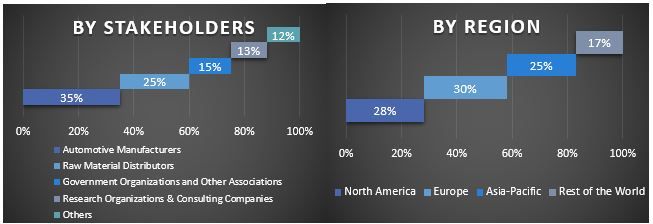
هندسة السوق
تم استخدام تقنية تثليث البيانات لإكمال تقدير السوق الإجمالي والوصول إلى أرقام إحصائية دقيقة لكل قطاع وفرع فرعي من سوق السيارات الكهربائية الفاخرة العالمي. تم تقسيم البيانات إلى عدة قطاعات وقطاعات فرعية بعد دراسة مختلف المعايير والاتجاهات في نوع الدفع ونوع السيارة ومناطق سوق السيارات الكهربائية الفاخرة العالمي.
الهدف الرئيسي لدراسة سوق السيارات الكهربائية الفاخرة العالمي
تم تحديد اتجاهات السوق الحالية والمستقبلية لسوق السيارات الكهربائية الفاخرة العالمي في الدراسة. يمكن للمستثمرين الحصول على رؤى استراتيجية لترسيخ تقديرهم للاستثمارات على التحليل النوعي والكمي الذي تم إجراؤه في الدراسة. حددت اتجاهات السوق الحالية والمستقبلية الجاذبية الإجمالية للسوق على المستوى الإقليمي، مما يوفر منصة للمشارك الصناعي لاستغلال السوق غير المستغلة للاستفادة من ميزة الريادة. تشمل الأهداف الكمية الأخرى للدراسات ما يلي:
- تحليل حجم السوق الحالي والمتوقع لسوق السيارات الكهربائية الفاخرة من حيث القيمة (بالدولار الأمريكي). أيضًا، قم بتحليل حجم السوق الحالي والمتوقع للقطاعات والقطاعات الفرعية المختلفة.
- تشمل القطاعات في الدراسة مجالات نوع الدفع ونوع السيارة والمناطق.
- تحديد وتحليل الإطار التنظيمي للسيارات الكهربائية الفاخرة
- تحليل سلسلة القيمة المتضمنة مع وجود وسطاء مختلفين، إلى جانب تحليل سلوكيات العملاء والمنافسين في الصناعة.
- تحليل حجم السوق الحالي والمتوقع لسوق السيارات الكهربائية الفاخرة للمنطقة الرئيسية.
- تشمل الدول الرئيسية في المناطق التي تمت دراستها في التقرير منطقة آسيا والمحيط الهادئ وأوروبا وأمريكا الشمالية وبقية العالم
- ملفات تعريف الشركات لسوق السيارات الكهربائية الفاخرة واستراتيجيات النمو التي يتبناها اللاعبون في السوق للاستمرار في السوق سريع النمو.
- تحليل متعمق على المستوى الإقليمي للصناعة
الأسئلة الشائعة الأسئلة الشائعة
س1: ما هو الحجم الحالي لسوق السيارات الكهربائية الفاخرة العالمي وإمكانات نموه؟
س٢: ما هي العوامل الدافعة لنمو سوق السيارات الكهربائية الفاخرة العالمي؟
س3: ما هي الشريحة التي لديها الحصة الأكبر في سوق السيارات الكهربائية الفاخرة العالمي حسب نوع نظام الدفع؟
س4: ما هي التقنيات والاتجاهات الناشئة في سوق السيارات الكهربائية الفاخرة العالمي؟
س5: أي منطقة ستسيطر على سوق السيارات الكهربائية الفاخرة العالمي؟
ذات صلة التقارير
العملاء الذين اشتروا هذا المنتج اشتروا أيضًا

